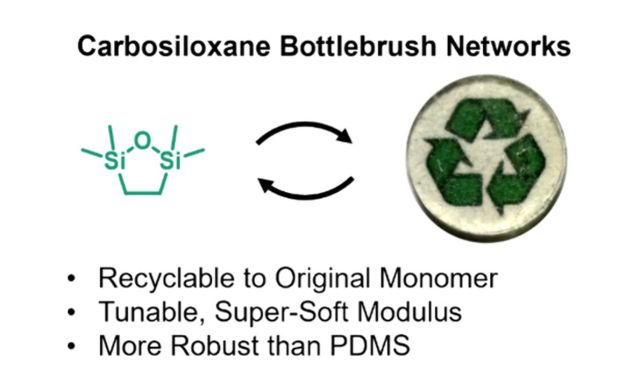
Carbosiloxane Bottlebrush Networks for Enhanced Performance and Recyclability
Taejun Eom, Patrick T. Getty, Michael Czuczola, Christopher M. Bates, Craig J. Hawker
Macromolecules Nov. 2024
Abstract: Silicone bottlebrush copolymers and networks derived from cyclic carbosiloxanes are reported and shown to have enhanced properties and recyclability compared with traditional dimethylsiloxane-based materials. The preparation of these materials is enabled by the synthesis of well-defined heterotelechelic macromonomers with Si–H and norbornene chain ends via anionic ring-opening polymerization of the hybrid carbosiloxane monomer 2,2,5,5-tetramethyl-2,5-disila-1-oxacyclopentane. These novel heterotelechelic α-Si–H/ω-norbornene macromonomers undergo efficient ring-opening metathesis copolymerization to yield functional bottlebrush polymers with accurate control over molecular weight and functional-group density. Si–H groups retained at the ends of side-chains after ring-opening metathesis copolymerization allow for the preparation of supersoft networks via hydrosilylation with cross-linkers such as tetrakis[dimethyl(vinyl)silyl]orthosilicate. In contrast to traditional PDMS systems, the incorporation of poly(carbosiloxane) side chains allows the resulting networks to be recycled back to the original monomer (>85% recovery) via depolymerization at elevated temperatures (250 °C) in the presence of base catalysts (potassium hydroxide and tetramethylammonium hydroxide). The recovered monomer was successfully repolymerized through anionic ring-opening polymerization with no decrease in structural fidelity or activity. In summary, this combination of unique (macro)monomer design and bottlebrush architecture creates new opportunities in sustainable practices by offering a robust, recyclable alternative to commercial silicone-based materials.